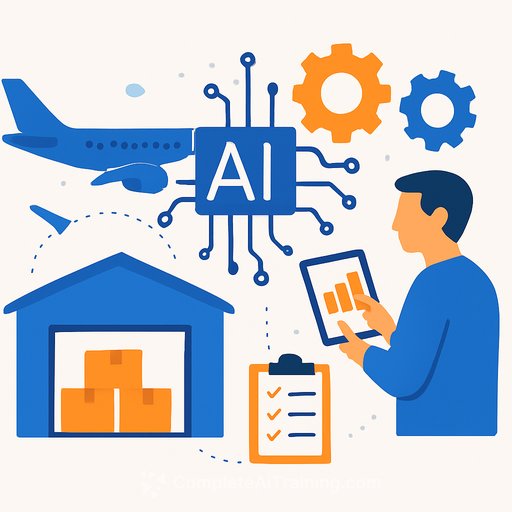AI-led post-purchase operations: Turn holiday chaos into loyalty, margin, and repeat sales
Holiday orders surge. Labor gets tight. And your team gets buried under "Where Is My Order?" calls just when misses hurt most. This is where AI-driven post-purchase delivery experience (PPDE) tools earn their keep - cutting support volume, boosting transparency, and keeping customers calm.
- AI deflects WISMO and improves delivery transparency with predictive tracking and automated updates.
- Customer experience is the top logistics priority over the next five years, surpassing automation and resilience.
- Personalized post-purchase portals drive engagement and incremental revenue through targeted offers.
- Smart returns workflows reduce friction and protect loyalty during peak demand.
Holiday e-commerce keeps growing, and expectations haven't eased. Shoppers still expect fast delivery and precise status updates, even at peak. Every gap in visibility becomes a support call or a lost customer. PPDE solutions close that gap and free your team to focus on genuine exceptions.
Why the post-purchase window matters more than ever
Delivery clarity is now a conversion lever and a loyalty moat. Unclear options at checkout push shoppers to abandon. After purchase, vague updates or missed ETAs trigger tickets and churn. Gartner data shows improving customer experience has moved ahead of automation as the No. 1 logistics goal - which squares with what ops teams see every peak season.
If you run operations, treat the post-purchase window like prime real estate. It's where expectations get set, promises get kept, and margin gets protected.
National Retail Federation holiday trends show consistent seasonal spikes. Plan your CX and support capacity with that surge in mind, not after it starts.
The AI advantage in reducing WISMO
WISMO is a cost engine. AI agents plugged into your tracking portal and social chat can answer status questions instantly, using real-time carrier data and machine learning to forecast delivery windows. They can also suggest alternate pickup points after a failed attempt - before the customer calls.
The upside: lower contact rates, faster resolution for true exceptions, and fewer escalations during the final stretch. The constraint: don't fly blind. Keep a clear human handoff when the bot struggles, and log every unresolved intent for quick tuning.
Risks to mitigate before scaling
- Impersonal or inaccurate responses erode trust. Require source-backed answers for status and ETAs.
- Data privacy and compliance. Set guardrails for PII handling and audit prompts and logs regularly.
- No dead ends. Offer easy escalation to a human and visible ways to call, chat, or email.
Balance matters. Automate the routine, make human support obvious, and publish service-level expectations in plain language.
Personalization that drives repeat purchases
Order updates are high-open communications. Use them. PPDE portals can insert targeted offers based on SKU, season, and past behavior - think "15% off matching mittens" after a winter hat purchase, or "faster shipping for small accessories" when a customer opts into updates.
Keep the offers relevant, sparse, and helpful. If every notification feels like a pitch, customers tune out. Treat it as context-aware merchandising inside a service moment.
What to measure
- Contact rate per 100 orders and WISMO deflection rate
- On-time delivery rate and ETA accuracy
- Click-through on status pages and offer conversion
- AOV uplift from post-purchase offers
- CSAT/NPS tied to delivery and returns interactions
Flexible returns: Turn friction into goodwill
Peak returns can swamp operations. PPDE platforms can simplify by generating labels, surfacing nearest drop-off or store options, and offering instant exchanges. You reduce back-and-forth, shorten cycle time, and save the sale.
Returns are a loyalty moment. Clear policies, instant credit on exchanges, and proactive "here's what happens next" messaging calm customers and cut repeat contacts.
Return KPIs to track
- Return initiation-to-refund cycle time
- Exchange save rate vs. refund rate
- Cost per return and carrier mix efficiency
- Defect/fit codes to drive upstream fixes
How to roll this out without blowing up your week
- Audit coverage: Identify carriers, data sources, and gaps in tracking granularity.
- Pilot one use case: Start with WISMO deflection on your tracking page and social DMs.
- Feed seasonal context: Cutoff dates, weather alerts, regional delays, store pickup hours.
- Brand the tone: Short, clear, friendly. Add seasonal phrasing without slowing the message.
- Set guardrails: Source-of-truth for status, privacy controls, and easy human escalation.
- Close the loop: Daily review of unresolved intents, false answers, and top causes of delay.
Baseline targets most ops teams can use
- 30-50% WISMO deflection in first 60 days of the pilot
- 10-20% reduction in average handle time for escalations
- 3-7% offer conversion on status-page placements
- 20-30% faster return cycle time via instant exchange options
Governance without the bureaucracy
- Single owner: One ops lead accountable for post-purchase CX, with clear SLAs.
- Weekly tuning: Review intents, add rules for edge cases, update carrier scripts.
- Risk reviews: Privacy checks, prompt audits, and fallback tests before each peak.
- Playbooks: Outage, weather, strike, and capacity-shift templates ready to deploy.
Want a structured way to skill up your team for AI in operations and customer service? Explore practical programs by job role at Complete AI Training.
FAQ
Q: What is a Post-Purchase Delivery Experience (PPDE) solution?
A: A unified platform that combines tracking, proactive communication, and returns management to improve transparency and satisfaction after checkout.
Q: How does AI reduce customer service volume during the holidays?
A: AI agents answer routine WISMO questions with real-time carrier data, provide accurate ETAs, and route true exceptions to humans - cutting queue length and costs.
Q: What are the main risks of relying on AI in post-purchase logistics?
A: Imprecise answers, privacy issues, and dead-end conversations. Mitigate with clear guardrails, auditing, and human escalation paths. See the NIST AI Risk Management Framework for guidance.
Q: How can companies begin implementing AI in post-purchase processes?
A: Start small with an AI-powered tracking or messaging pilot, load it with seasonal scripts, monitor results daily, and scale as accuracy and CX improve.
As online holiday orders surge, AI-enabled post-purchase tools help operations leaders maintain delivery visibility, deflect service calls, and protect loyalty - while easing strain on teams when it matters most.
Your membership also unlocks:






